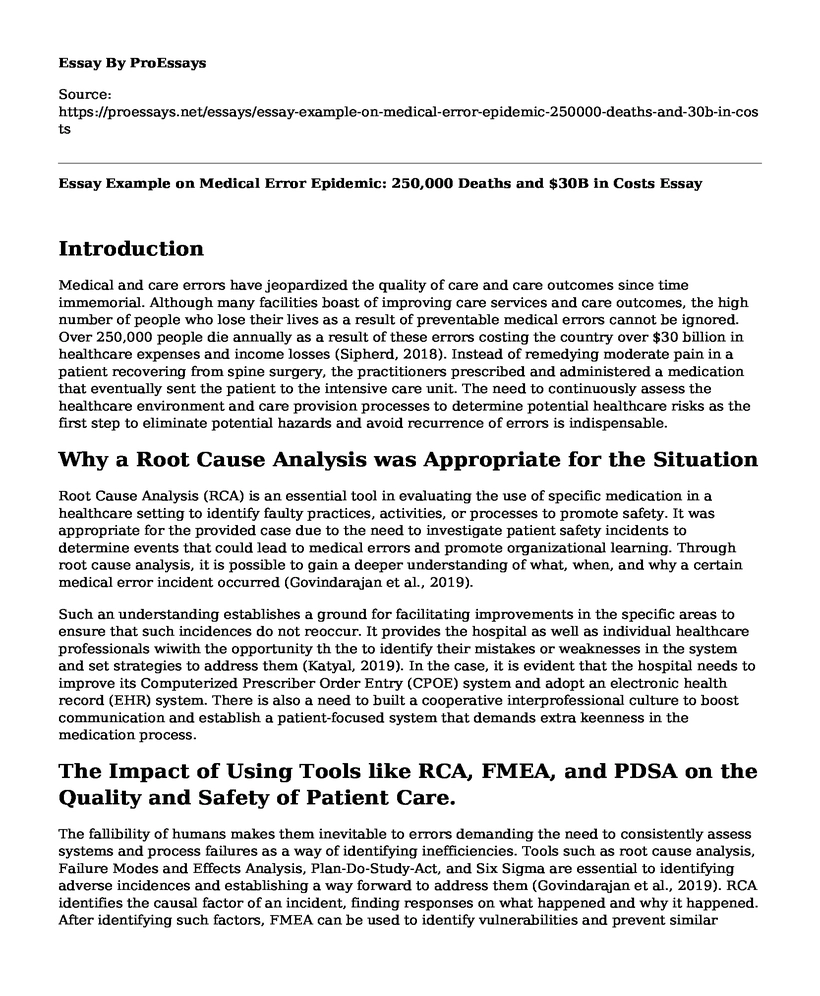Introduction
Medical and care errors have jeopardized the quality of care and care outcomes since time immemorial. Although many facilities boast of improving care services and care outcomes, the high number of people who lose their lives as a result of preventable medical errors cannot be ignored. Over 250,000 people die annually as a result of these errors costing the country over $30 billion in healthcare expenses and income losses (Sipherd, 2018). Instead of remedying moderate pain in a patient recovering from spine surgery, the practitioners prescribed and administered a medication that eventually sent the patient to the intensive care unit. The need to continuously assess the healthcare environment and care provision processes to determine potential healthcare risks as the first step to eliminate potential hazards and avoid recurrence of errors is indispensable.
Why a Root Cause Analysis was Appropriate for the Situation
Root Cause Analysis (RCA) is an essential tool in evaluating the use of specific medication in a healthcare setting to identify faulty practices, activities, or processes to promote safety. It was appropriate for the provided case due to the need to investigate patient safety incidents to determine events that could lead to medical errors and promote organizational learning. Through root cause analysis, it is possible to gain a deeper understanding of what, when, and why a certain medical error incident occurred (Govindarajan et al., 2019).
Such an understanding establishes a ground for facilitating improvements in the specific areas to ensure that such incidences do not reoccur. It provides the hospital as well as individual healthcare professionals wiwith the opportunity th the to identify their mistakes or weaknesses in the system and set strategies to address them (Katyal, 2019). In the case, it is evident that the hospital needs to improve its Computerized Prescriber Order Entry (CPOE) system and adopt an electronic health record (EHR) system. There is also a need to built a cooperative interprofessional culture to boost communication and establish a patient-focused system that demands extra keenness in the medication process.
The Impact of Using Tools like RCA, FMEA, and PDSA on the Quality and Safety of Patient Care.
The fallibility of humans makes them inevitable to errors demanding the need to consistently assess systems and process failures as a way of identifying inefficiencies. Tools such as root cause analysis, Failure Modes and Effects Analysis, Plan-Do-Study-Act, and Six Sigma are essential to identifying adverse incidences and establishing a way forward to address them (Govindarajan et al., 2019). RCA identifies the causal factor of an incident, finding responses on what happened and why it happened. After identifying such factors, FMEA can be used to identify vulnerabilities and prevent similar failures in the future. It identifies what could go wrong and focuses on how to avoid or improve it. PDSA positively impacts how quality improvement projects are undertaken as a way of promoting favorable outcomes. Six-sigma can assist in eliminating or minimizing wastage and streamlining care provision processes leading to low cases of errors.
Conclusion
It is evident that assessing medical errors is an imperative practice in promoting patient safety and quality of care. From the short analysis, there are various tools that healthcare facilities can use to assist in limiting chances for errors and adverse events and improve processes, systems, and activities for better healthcare outcomes. Effective use of the tools, including RCA, FMEA, PDSA, and Six-Sigma, is crucial in setting the pace for quality improvement, and overcoming care challenges that continue to thwart the effectiveness of numerous healthcare facilities.
References
Govindarajan, R., Kaur, H., & Yelam, A. (2019). Tools and strategies for quality improvement and patient safety: A primer for healthcare providers. Improving Patient Safety, 263-273. https://doi.org/10.1201/9781498785037-6
Katyal, N. (2019). Introduction to patient safety and medical errors. Improving Patient Safety, 1-6. https://doi.org/10.1201/9781498785037-1
Ray Sipherd. (2018, February 28). The third-leading cause of death in the US most doctors don't want you to know about. CNBC. https://www.cnbc.com/2018/02/22/medical-errors-third-leading-cause-of-death-in-america.html
Cite this page
Essay Example on Medical Error Epidemic: 250,000 Deaths and $30B in Costs. (2023, Aug 08). Retrieved from https://proessays.net/essays/essay-example-on-medical-error-epidemic-250000-deaths-and-30b-in-costs
If you are the original author of this essay and no longer wish to have it published on the ProEssays website, please click below to request its removal:
- Research Paper on Educational and Professional Goals and the DNP Degree
- Research Paper on Obesity in UAE (United Arab Emirates)
- Essay Example on Doctors Ethics: Put Patients First, Not Profits
- Essay Sample on Type 2 Diabetes: Causes, Treatments, and Prevention
- Essay Example on the Benefits of Being a Vegetarian: Supporting a Greener Environment
- Essay Example on CBT: An Effective Treatment for Depression & Its Related Conditions
- Remote Area Nurses: Prevalent Victims of Occupational Violence Paper







